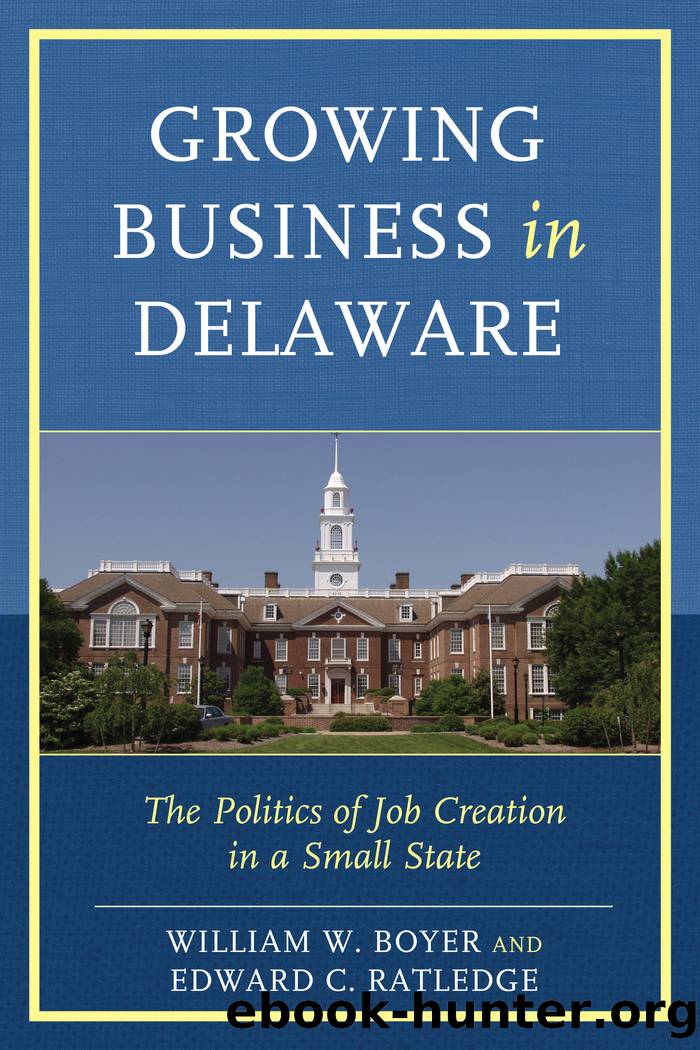Growing Business in Delaware by Boyer William W.;Ratledge Edward C.;

Author:Boyer, William W.;Ratledge, Edward C.;
Language: eng
Format: epub
Tags: undefined
Publisher: University of Delaware Press
Published: 2012-08-15T00:00:00+00:00
Conclusion
In retrospect, the Bloom Energy deal remained complex, to say the least. It employed mechanisms not usually found in economic development. In general, most economic development strives to generate positive returns in jobs, income, and income taxes. In this case, however, economic development was conflated with environmental policy and negative results. The special legislation permitting natural gas to be considered a renewable energy continued to strain credulity, with the entire cost of Bloomâs residency in Delaware having been shouldered by ratepayers independent of any benefits to offset that burden.
Over a twenty-year period, this strategy portended job losses that far exceed anything Bloom Energy was likely to produce. Even toward the end of 2014, its promise of creating nine hundred jobs by the end of 2016 appeared to be a pipe dream. Relative to its agreement with the state, Bloom Energy had only hired 208 full-time employees instead of its promised three hundred by September 2014, and it promised to hire six hundred by a year later and nine hundred by a year after thatâtargets that seemed unlikely to be met.[47]
Not only were taxpayers likely to pay more with the grants given to Bloom, but also their utility rates already had become far higher than they had been without Bloom.[48] Taxpayers had been given the privilege of buying very expensive electricity with no discernible return. In fact, the true cost of that privilege was grossly underestimated from the beginning. An initial surcharge cost expected to be $1.04 per one kilowatt hour had exploded to nearly $6 in early 2014. For some consumers, the surcharge cost per month became nearly $30; compared with those who had taxpayer-subsidized solar power, for whom the cost was nominal.
A June 2014 class action lawsuit against Delmarva Power and its parent company Pepco Holdings Inc., on behalf of all Delmarva customers, alleged that Bloom Energy servers were not as energy efficient as claimed. The suit alleged that Bloom was using more natural gas than allowed under the permits with DNREC, asserting: âDelmarva knowingly and recklessly concealed or suppressed knowledge that Bloom servers consumed more natural gas and therefore, emitted more carbon dioxide than allowed under the permits with the intent to deceive its electricity customers into believing that using Bloom servers created cleaner electricity in exchange for a higher electric charge.â[49] DNRECâs response in July 2014 was that it erred in not updating its permit to Bloom as the project grew larger, and therefore it would reissue a new Bloom Energy electrical project permit allowing its fuel cells to consume more natural gas.[50]
In September 2014, Governor Markell announced that Bloom Energyâs plant in Newark, not those in California, was producing âpretty much allâ of its servers. Sam Jaffe, principal research analyst of Navigant Research in Colorado, commented: âIt is impossible for an outsider to measure how much production is going on at Bloom, because it is a private company that closely guards its secrets.â Noting that most of Bloomâs customers were in California, but that its customer
Download
This site does not store any files on its server. We only index and link to content provided by other sites. Please contact the content providers to delete copyright contents if any and email us, we'll remove relevant links or contents immediately.
The Motivation Myth by Jeff Haden(5156)
Audition by Ryu Murakami(4850)
Adulting by Kelly Williams Brown(4488)
The Confidence Code by Katty Kay(4189)
A Mind For Numbers: How to Excel at Math and Science (Even If You Flunked Algebra) by Barbara Oakley(3221)
Waiting in the Wings by Melissa Brayden(3179)
Self-Esteem by Matthew McKay & Patrick Fanning(3093)
Fooled by Randomness: The Hidden Role of Chance in Life and in the Markets by Nassim Nicholas Taleb(3046)
The ONE Thing by Gary Keller(3009)
Nice Girls Don't Get the Corner Office by Lois P. Frankel(2996)
The Dictionary of Body Language by Joe Navarro(2947)
How to be More Interesting by Edward De Bono(2748)
Designing Your Life by Bill Burnett(2667)
Getting Things Done by David Allen(2646)
The Plant Paradox by Dr. Steven R. Gundry M.D(2547)
Police Exams Prep 2018-2019 by Kaplan Test Prep(2487)
What Color Is Your Parachute? 2015 by Richard N. Bolles(2264)
Dangerous Personalities by Joe Navarro(2234)
When to Jump by Mike Lewis(2204)
